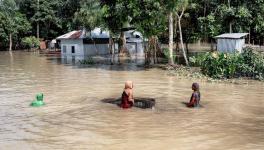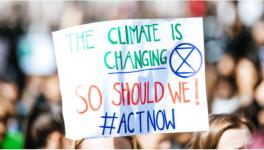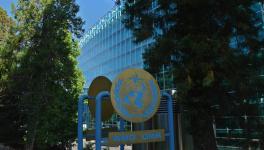Stark Choices in Copenhagen
The Copenhagen Conference starts today, with a stark choice facing the world. We either cut global carbon emissions soon, going to near zero by the end of the century or we are on a slippery slope to climate disaster. Even worse, the data shows that we are exceeding the worst-case scenario of the 2006 IPCC Report. A group of scientists have collated the last three year figures on Arctic and Antarctic ice melts, the sea-rise over the last few years and the temperature rise. All of these indicate that things are getting worse for us and time is fast running out on taking immediate and drastic action.
The rich and industrialised counties, who today have about three fourths of the stock of carbon emissions in the atmosphere are dragging their feet on the steps to be taken. The US is now talking about a 17% cut by 2020 using 2005 as the base year and that too as a national commitment and not an internationally binding target. The other industrialised countries have now fallen in line with the US and are committing far less than what the world requires. If we total up all their commitments, the target would be around 11 to 18% and far below the deep 40% cuts required by 2020. The logic of this is quite simple. The slower and later the industrialised countries cut their emissions, the less the carbon space for the developing countries. They will either have to sacrifice future development itself or choose a much more expensive low-carbon trajectory of development, while the rich countries continue with their profligate carbon emissions and grabbing even more carbon space.
The reality of global warming is that time is running out on us. If we adopt the path of predatory capitalism – how much carbon space can we grab from others – the path the rich countries are following, the future is bleak. Already, a group of scientists have marshalled data that shows that we are now outside the worst-case scenario of the IPCC on all counts. The loss of ice from the polar ice caps and the rise in sea level is occurring faster than IPCC had predicted. The carbon emissions are also rising faster than IPCC's worst-case predictions. “Summer-time melting of Arctic sea-ice has accelerated far beyond the expectations of climate models. The area of summertime sea-ice during 2007-2009 was about 40% less than the average prediction from IPCC AR4 climate models.”
With failure of leadership from the rich industrialised countries, it is the developing world that is showing leadership. The African countries made clear in the penultimate round of discussions before Copenhagen that the rich countries needed to put numbers on the table without which no other discussion would proceed. China, Brazil, Indonesia and now India have all made unilateral commitments for reducing carbon intensity of their GDP and lowering of growth rate of emissions. All this has made clear that it is the club of the rich, who are holding up meaningful climate action.
The basic issues before Copenhagen are how to share the remaining carbon space and who will bear the cost of the low-carbon trajectory that the developing countries will have to follow in the future. On both these counts, the rich countries have a multi-pronged attack on the developing countries. The first attack is to do away with the Kyoto Protocol and talk about a new treaty. The Kyoto Protocol had made clear the difference between rich countries who have caused the problem with their high emissions and the developing countries that will now have to bear the burden due to to the carbon stock of the rich countries. The talk of a new protocol is to do away with this vital distinction. This will also allow the rich countries to shift the base year from 1990 to 2005, therefore considerably reducing the cuts they would otherwise have to make. By 1990 levels, the US's current offer (17% over 2005 by 2020) is virtually a zero cut. The second attempt is to put all countries in a common basket and do way with the distinction between Annex 1 countries, who with 20% population have 75% the current stock of carbon in the atmosphere and the others who with 80% of the world's population, have only 25% of carbon stock. The last attack is to virtually do away with financial and technology transfers. The promise that the US and the EU are making is around $ 5-10 billion per annum against a minimum requirement of $100-300 billion. Technology transfers and access, built into the Kyoto Protocol is not even on offer in Copenhagen. This, in the view of the rich countries, must follow the market principles. The god of market must prevail, even if it means destruction of the world.
There are now two contending drafts that will be circulated in Copenhagen – one is the Danish draft, which has the support of the club of the rich. The second is the BASIC draft – the one hammered out by China, South Africa, Brazil and India. The developing countries, some of who have been allowed to peek into the Danish draft, have already said that it is unacceptable as it is a complete departure from Kyoto.
We will be able to comment further when we see both the drafts. At present, we will know the main contours of the BASIC draft, which roughly takes forward the Kyoto agenda.
While the Indian position publicly remains congruent to the BASIC position to which it is party, the Minister's of Environment, Jairam Ramesh's statement, first in Parliament and later in an interview with Times of India, has created a lot of confusion. It is now public that the two of the negotiators postponed their departure to Copenhagen seeking “clarifications” from the Minister. Though sources close to the Minister tried to portray this as a difference on India's unilateral offer on carbon intensity, as C. Dasgupta's press statement made clear, it was on more substantive issues.
The issues are Jairam Ramesh's virtual trashing of the per capita basis of India's negotiating position. This goes even against the PM's assurance in Hiliegendamm that India's per capita emissions will not exceed that of the rich countries. The second is watering down the distinction between Annex 1 and non Annex 1 countries. The last is moving away from the Kyoto Protocol's basic formulation that the actions of developing countries are linked to financial and technology transfers from the developed countries. Instead, the Minister talked about technology development and ran down technology transfers and technology access.
These are not matter of flexibility or nuances as the Minister would have us believe but fundamental to India's future. This kind of repeated shifts in position has created a doubt in the developing countries about India's intentions in Copenhagen. All the goodwill India earned in its championing the developing countries cause right from Kyoto, is being lost with the Minister's cavalier dismissal of India's stated positions on climate change.
We will have to watch carefully what happens in Copenhagen and what the Indian delegation does there. The future of the world and the future development of the poorer countries are at stake. Only a vigilant people can force its leaders to do the right thing in Copenhagen. In addition, in India, we have the additional task of seeing India does not break ranks with the developing countries. The next 10 days are crucial for all of us and our future.
Get the latest reports & analysis with people's perspective on Protests, movements & deep analytical videos, discussions of the current affairs in your Telegram app. Subscribe to NewsClick's Telegram channel & get Real-Time updates on stories, as they get published on our website.























